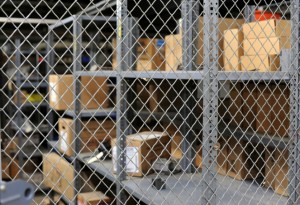In a perfect world, there would be no need to worry about the possibility of inventory being stolen. Sadly, many businesses lose a pretty big chunk of change every year due to theft. It can be tough to know if inventory “shrink” is because of waste, breakage or theft. The first thing you should do is make sure your staff are required to record all waste (like offcuts, residuals etc.) and breakage (items that are literally broken in production, assembly or handling) to a supervisor. The supervisor should keep track of waste and breakage on a daily basis and deduct it from inventory either daily or weekly. This can also help the supervisor with remedial training or process improvements if there are patterns with certain staff or certain processes.
After you have identified waste and breakage, the rest of the shrink is likely due to theft. If you’re losing money because a measurable portion of your inventory is being stolen, there are a few inventory management techniques you can employ. Remember – depending on your business, inventory can disappear either through customer or employee misdeeds……Here are five techniques to help you reduce loss of inventory by theft:
1. If you have a physical store, your inventory management efforts will need to include efforts to prevent shoplifting. If you notice that shoplifting is a problem, you may want to install security cameras and educate your employees about loss prevention and in-store inventory control. Even if you don’t have a physical store – you might want to use tracking methods such as cameras and time-clocks so that you know which employees are around the inventory at all times.
2. Make sure your employees know that you are carefully keeping track of your inventory with highly efficient inventory management techniques. Employee theft is far less likely if inventory systems are well-run and organized.
3. Only allow trained and trusted employees to edit data in your inventory management software. It’s easy to change a few numbers in the inventory software so no one realizes products are gone. Many software systems require a unique logon and therefore updates to inventory can be tracked by user. Make sure employees do not share user ID or passwords. This will give you the ability to audit changes made to inventory numbers if you ever identify a problem.
4. On a related note, it’s a good idea to password protect your inventory tracking software and any other business software you use. You can then choose to only give the password to employees who deal directly with your inventory management or supply chain management. Again – make the user ID and password unique to each individual that has access.
 5. Store your inventory in a secure place. This may seem obvious, but where inventory is stored is sometimes overlooked. You should try to set up some kind of protocol with your employees to ensure that doors are always locked and alarms are always set. Only allow certain employees (either line supervisors or managers) to have access to the most expensive inventory items. That way – they are accountable for those items. You can often utilize a “cage” within your warehouse for really important stuff or use locked cabinets in your retail store like you see in jewelry shops (and only give managers the keys!). Small steps like this can save you a fortune in the long run.
5. Store your inventory in a secure place. This may seem obvious, but where inventory is stored is sometimes overlooked. You should try to set up some kind of protocol with your employees to ensure that doors are always locked and alarms are always set. Only allow certain employees (either line supervisors or managers) to have access to the most expensive inventory items. That way – they are accountable for those items. You can often utilize a “cage” within your warehouse for really important stuff or use locked cabinets in your retail store like you see in jewelry shops (and only give managers the keys!). Small steps like this can save you a fortune in the long run.
If you are using the right inventory management techniques, there’s no need to worry about inventory theft. Just arm yourself with a highly organized inventory management system!
